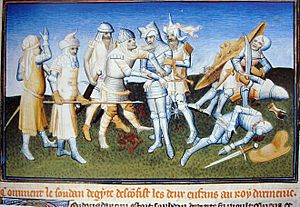Leo II, King of Armenia facts for kids
Quick facts for kids Leo IIԼէոն Բ |
|
|---|---|
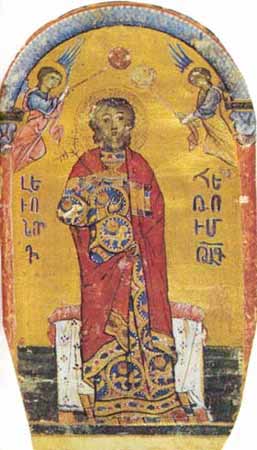
Portrait of Prince Levon by Toros Roslin, 1250.
|
|
| King of the Armenian Kingdom of Cilicia | |
| Reign | 1269/1270 – 1289 |
| Predecessor | Hetoum I |
| Successor | Hetoum II |
| Born | 1236 |
| Died | 1289 (aged 52–53) |
| Spouse | Keran of Lampron |
| Issue …among others |
Hethum II Thoros III Sempad Isabella of Armenia, Princess of Tyre Constantine I Rita, Byzantine Empress Oshin |
| House | Lambron |
| Father | Hetoum I |
| Mother | Isabella |
| Religion | Armenian Apostolic |
Leo II (also known as Leon II or sometimes Leo III) was a king of the Armenian Kingdom of Cilicia. He ruled from 1269 or 1270 until 1289. Born around 1236, Leo was the son of King Hetoum I and Queen Isabella. He belonged to the important House of Lampron family.
Early Life and Challenges
Leo was born in 1236. His parents, King Hetoum I and Queen Isabella, had married in 1226. This marriage helped bring peace between important families in Armenia. Leo was their oldest child among six children. One of his sisters, Sibylla of Armenia, married Bohemond VI of Antioch. This marriage also helped create peace between Armenia and Antioch.
In 1262, Leo married Keran, who was the daughter of Prince Hetoum of Lampron. This marriage made his connection to the powerful House of Lampron even stronger.
A big challenge came in 1266. While his father, King Hetoum I, was visiting the Mongol court, Leo and his younger brother Thoros faced a huge army. This army was made up of Mamluk invaders. They fought at the Battle of Mari. Sadly, Thoros was killed in the battle, and Leo was captured and put in prison.
After this defeat, several Armenian cities were attacked. The capital city of Sis was even burned down. Thousands of Armenians were killed, and many more were taken captive. When King Hetoum returned, he had to pay a large amount of money to get his son Leo back. He also had to give up some fortresses and help free a relative of the Mamluk leader, Baybars.
King Leo's Reign
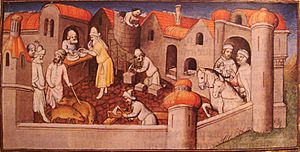
In 1269, King Hetoum I decided to step down from the throne. He chose his son Leo to become the new king. Hetoum then joined a religious group called the Franciscans and died a year later. King Leo II was known for being a very religious and devoted Christian ruler.
He worked hard to improve trade with countries in the West. He renewed old trade agreements with Italian merchants. He also created new agreements with people from Catalonia. King Leo also continued to strengthen the alliance with the Mongols. His father, Hetoum I, had made Armenia a part of the Mongol Empire in 1247.
In 1275, the Mamluk sultan Baybars attacked Cilicia again. The next year, Armenia successfully fought off an invasion by Turkoman tribes. However, Leo's uncle, Constable Sempad, was killed in this battle.
Working with the Mongols
In 1281, King Leo joined the Mongols in their attack on Syria. But they were defeated at the Second Battle of Homs. After this, Leo had to ask for peace. In 1285, he managed to get a 10-year truce with the Mamluks. In return, Armenia had to give up some important lands to the Mamluks.
King Leo died in 1289. After his death, his son Hetoum II became the new king.
Family and Descendants
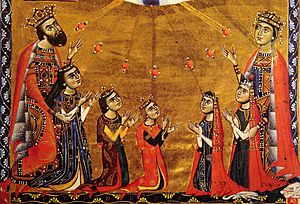
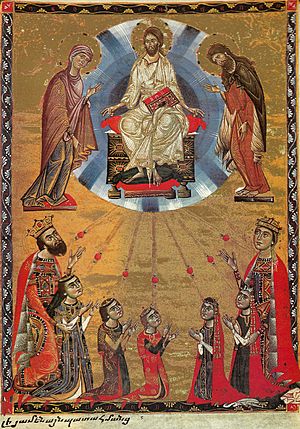
King Leo and Queen Keran were married for 21 years. They had many children, sixteen in total: ten sons and six daughters. Five of their children later became rulers of Armenia.
Their oldest son, Hethum II of Armenia, became king first. He later gave up the throne for his younger brother, Thoros III of Armenia. However, Hetoum II became king again in 1294. Their brother Sempad of Armenia later took power, even hurting Hetoum and killing Thoros. Sempad was then overthrown by another brother, Constantine I.
Eventually, Hetoum II became king again. He then gave the throne to Thoros III's son, Leo III of Armenia. Sadly, Leo III and his uncle Hetoum II were killed in 1307. Another of Leo and Keran's younger sons, Oshin of Armenia, then became king. The royal line eventually passed to the children of Leo and Keran's oldest surviving daughter, Isabella of Armenia.


